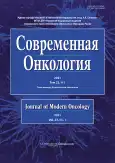Clinical and morphological case of lung cancer with generalized metastases to the internal organs
- Authors: Vorobeva O.V.1
-
Affiliations:
- Ulianov Chuvash State University
- Issue: Vol 23, No 3 (2021)
- Pages: 525-528
- Section: CLINICAL ONCOLOGY
- URL: https://journals.rcsi.science/1815-1434/article/view/58195
- DOI: https://doi.org/10.26442/18151434.2021.3.200856
- ID: 58195
Cite item
Full Text
Abstract
Lung cancer has occupied a leading position in the structure of cancer morbidity and mortality throughout the world for many years. Lifetime diagnosis is often difficult due to the absence of any defining signs of cancer, and it is quite difficult to track the first signs of lung cancer. This is justified by the fact that the lungs are completely devoid of nerve endings and the presence of 26% of healthy lung tissue is sufficient to provide the body with the required amount of oxygen. Prolonged absence of clinical manifestations leads to late seeking medical help, which is often fatal. Description of the case. A 65-year-old patient who died at home was referred for a postmortem examination. The sectional study revealed signs of peripheral cancer of the right lung with multiple metastases in all fields of the lungs, in the liver, spleen, pancreas, with no metastases in the lymph nodes. Histological examination revealed extensive areas of tumor tissue, consisting of solid structures with glandular differentiation of tumor tissue of various sizes and shapes, with round and oval atypical nuclei. There was a pronounced polymorphism of cells, with a large number of pathological mitoses. Thrombi were detected in the lumen of the segmental and small branches of the pulmonary artery. Thus, the presented case is of particular interest for practicing physicians due to the fact that with adenocarcinoma of the lung, there were no characteristic metastases to the lymph nodes. Hematogenous metastasis occurred with the development of generalized metastases to the internal organs.
Keywords
Full Text
##article.viewOnOriginalSite##About the authors
Olga V. Vorobeva
Ulianov Chuvash State University
Author for correspondence.
Email: olavorobeva@mail.ru
ORCID iD: 0000-0003-3259-3691
Сand. Sci. (Med.)
Russian Federation, CheboksaryReferences
- Усачев В.С., Смоленов Е.И., Рагулин Ю.А. Морфологическая и молекулярно-генетическая диагностика рака легкого: методики и проблемы. Исследования и практика в медицине. 2020;7(3):51-62 [Usachev VS, Smolenov EI, Ragulin YuA. Morphological and molecular genetic diagnosis of lung cancer: methods and problems. Research and Practical Medicine Journal. 2020;7(3):51-62 (in Russian)]. doi: 10.17709/2409-2231-2020-7-3-5
- Bombí JA, Martínez A, Ramírez J, et al. Ultrastructural and molecular heterogeneity in non-small cell lung carcinomas: study of 110 cases and review of the literature. Ultrastruct Pathol. 2002;26(4):211-8.
- Fisseler-Eckhoff A. Prognostic factors in histopathology of lung cancer. Front Radiat Ther Oncol. 2010;42:1-14. doi: 10.1159/000262457
- Gomes M, Teixeira AL, Coelho A, et al. The role of inflammation in lung cancer. Adv Exp Med Biol. 2014;816:1-23. doi: 10.1007/978-3-0348-0837-8_1
- Königshoff M. Lung cancer in pulmonary fibrosis: tales of epithelial cell plasticity. Respiration. 2011;81(5):353-8. doi: 10.1159/000326299
- Tufman AI, Huber RM. Biological markers in lung cancer: a clinician’s perspective. Cancer Biomark. 2010;6(3-4):123-35. doi: 10.3233/CBM-2009-0124
- Dabbs DJ. Diagnostic Immunohistochemistry. Philadelphia, Elsevier, 2006.
- Wood SL, Pernemalm M, Crosbie PA, Whetton AD. The role of the tumor-microenvironment in lung cancer-metastasis and its relationship to potential therapeutic targets. Cancer Treat Rev. 2014;40(4):558-66. doi: 10.1016/j.ctrv.2013.10.001
- Воробьева О.В., Ласточкин А.В. Клинико-морфологический случай аденокарциномы слюнной железы с развитием генерализованных метастазов. Вопросы онкологии. 2020;66(4):425-8 [Vorobeva OV, Lastochkin AV. Сlinical and morphological case of salivary gland adenocarcinoma with the development of generalized metastases. Voprosy onkologii. 2020;66(4):425-8 (in Russian)].
Supplementary files












